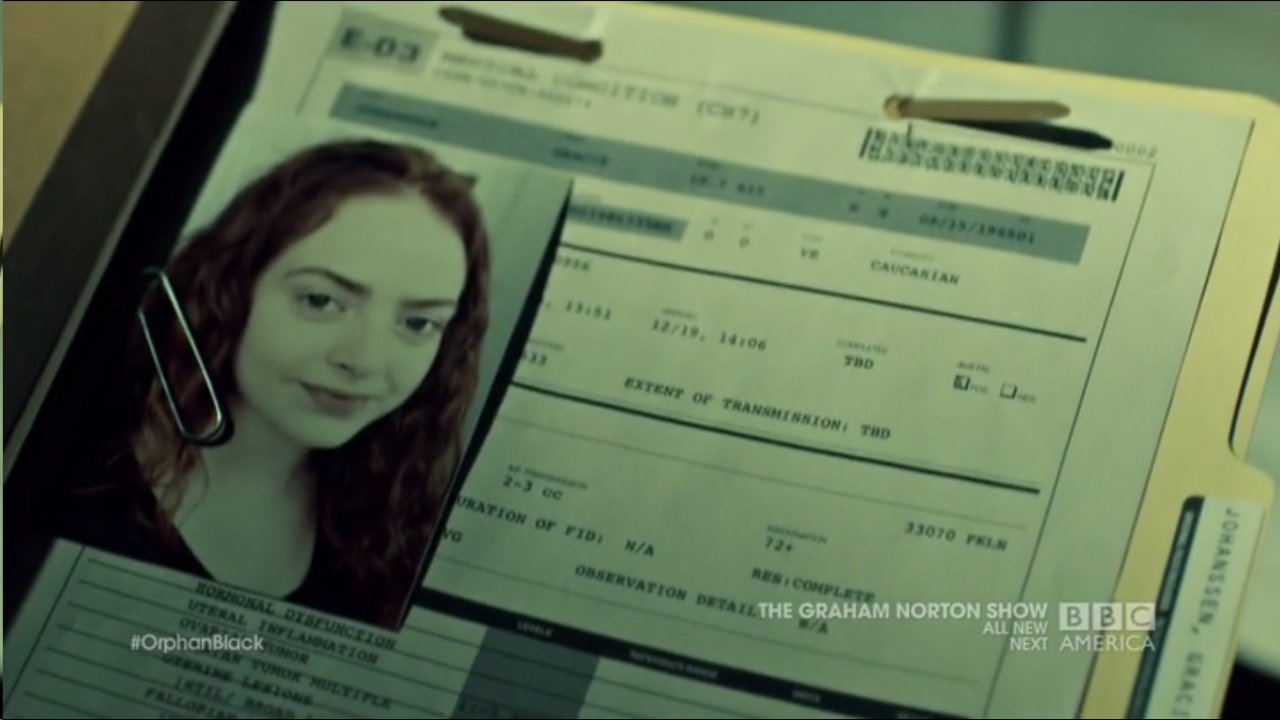Welcome to our Orphan Black science recaps, where Casey, a graduate student in genetics and developmental biology, and Nina, a professional science communicator, examine the science in each episode of OB and talk you through it in (mostly) easy-to-digest terms. Check out our regular OB recap for this episode here.
If you haven’t watched the latest episode of Orphan Black, be forewarned: there will be spoilers. There will also be crazy science.
Nina: Finally! The Castor defect is explained! Well, sort of. Paul made a lot of discoveries about the nature of the defect, its symptoms, and its transmission, but then he literally destroyed them all. Cosima’s piecing together the same information from the science research end of things, but she’s not quite there yet. The fact is, in this episode it’s clear that Cosima’s been spending her free time being all romantic and stuff and not so much focusing on her science (hey—no judgment! She deserves some happiness!). Of course, Delphine steps in and reminds us that she is still a scientist and not just Rachel’s replacement by calling Cosima and Scott out for missing a big ol’ proteinaceous red flag in their clone disease research.

Not awkward. At. All.
Casey: Delphine noticed that there is a misfolded protein in both Gracie’s samples and the samples from Seth’s brain. This points to a prion disease, which we discussed in an earlier recap. Prions are misfolded proteins that have the ability to cause other proteins to misfold, and then they accumulate in the tissue and cause degradation of healthy cells.
The most well known prion diseases are Creutzfeldt-Jakob Disease, spongiform encephalopathy, and mad cow disease. These are all disorders that affect the brain, in much a similar way as the Castor glitching.
What is interesting about the Orphan Black defect is that Coady explained that the Castor glitching, the Castor sexually transmitted infection, and the Leda clone disease are all caused by the same prion. This prion is what gives the Castor clones their weapon function, but it also has the unfortunate side effect of destroying their brains. This prion is also what makes the Leda clones infertile, but has the unfortunate side effect of the autoimmune disease that spreads to the lungs and other organs.
Nina: What bothers me is that I’ve never heard of a prion disease that doesn’t affect the brain. The Castor defect symptoms are exactly what you’d expect from a prion disease. The Leda disease is completely different. I mean, there are a lot of disease that are sexually dimorphic—some STIs, genetic diseases, and autoimmune disease present differently in men and women, but I have a hard time wrapping my brain around a prion—the same prion—being behind both diseases when they are so different and specifically target different tissues.
Casey: One reason for why the prion could be affecting the Castor clones in their brains and the Leda clones in their endothelial tissue is that the sequences, while the same in both clones, are in different parts of the genome and therefore expressed under different regulatory elements. This could explain why different tissues are at risk for deterioration in the two different sets of clones.
Why is the prion sexually transmitted in the Castor clones but appears to not be transmitted to the Leda clones’ sexual partners? This could be because there is a separate synthetic sequence in the Castor genome that allows for transmission via the sperm or semen, but this sequence is not in the Leda clones and therefore cannot be passed to others. The Castor clones may have this sequence because they were created to be sterilization weapons, so they needed a way for this prion to be transmitted.
Nina: There’s also the issue of the differences between the symptoms found in Leda clones versus women infected by Castor. The end result is the same: infertility, but the progression is way faster in the non-clone women who became infected. Also, the symptomatic Leda clones are, you know, coughing up blood but not getting weird eye hemorrhaging (and vice versa for the non-clones). This could be strictly due to basic differences between the two clone diseases, as Casey suggested. Also the disease may behave slightly differently because one is a genetic or familial variant, while the other is transmissible. With prion diseases like Creutzfeldt-Jakob, inherited CJD tends to show a later onset, progresses more slowly, and has an overall longer duration (it’s always fatal) than CJD acquired through infection, which generally moves much more quickly. Hmmm… sounds familiar.

Casey: Why is Sarah Manning (and naturally, Helena) immune to this prion? Her immunity could have been planned from the start. The clone Amelia was carrying was originally supposed to be the clone raised by the Duncans. It is possible that Ethan and Susan secretly added in an immunity to the prion to this clone as a sort of fail safe, or to keep the option of a reproducing clone open. This clone then became twins that were hidden away, giving us the fertile mirror twins who now may hold to key to curing all the clones.
Casey Griffin is a graduate student in genetics and developmental biology. She dissects mouse hearts, does lots of PCRs, and nerds (and cries and screams) about Orphan Black. You can check out her OB Science Time Tumblr posts here.
Nina Nesseth is a professional science communicator, emerging playwright, and serial tea-drinker. She’s happiest when science-ing at people (yes, that’s “science” as a verb) and watches way too many movies (but she lacks stamina and falls asleep if she tries to watch two in a row). You can find her on Twitter @cestmabiologie.
—Please make note of The Mary Sue’s general comment policy.—
Do you follow The Mary Sue on Twitter, Facebook, Tumblr, Pinterest, & Google +?









Published: May 28, 2015 11:50 am